The ASUS ROG Strix B360-G Gaming Review: A Polarizing $100 Motherboard Design
by Joe Shields on September 25, 2018 8:00 AM EST- Posted in
- Motherboards
- Intel
- Asus
- MicroATX
- CrossFire
- M.2
- Coffee Lake
- i7-8700K
- B360
BIOS
ASUS' UEFI BIOS on this B360 based board shares the same styling and aesthetic as the current ASUS flagship ROG boards. About the only difference between them will be that most of the overclocking options on these boards will not be here since the B360 chipset does not allow for overclocking.
In familiar fashion, we have an EZ Mode as well as an Advanced mode for the BIOS.
ASUS' EZ Mode, like on other ASUS boards, displays information about the hardware in use including the CPU and memory capacity/speed. Users are able to gather high-level information from this screen such as core voltage as well as motherboard and CPU temps. From this section, we are able to set XMP profiles on our memory, adjust CPU fan speeds through QFan Control, as well as adjust boot order. Most anything else will have to be changed from the advanced section of the BIOS.
Our first glimpse of the Advanced BIOS shows a list of headings across the top. The first section is titled Main, and we see more detailed information about the system including BIOS build date, PCH stepping, CPU speed, memory capacity and speed, as well as the system date.
The next section is Ai Tweaker. On Z370 based boards, we are used to seeing many more options due to overclocking. In this case, options are minimized on the CPU and memory overclocking side though if adjusting memory timings is your thing, the B360-G Gaming has plenty of those to tweak.
Moving on to the Advanced section, users are able to see several different options which allow control over the board from CPU, System Agent, and chipset configuration along with other peripheral functionality. Option for the network, NVMe, USB, and HDD/SSD configurations are also located in this section.
The Monitor area displays motherboard and CPU temperatures along with fan speeds for any that are attached. ASUS' Q-Fan can also be accessed here. Q-Fan sets up fan thresholds by running the fans through its fastest and lowest speeds and setting things accordingly.
The Boot section is fairly self-explanatory with all boot options housed under this heading.
The Tools section of the BIOS includes the EZ Flash 3 Utility as well as storing user profiles/settings. This section also contains a Secure Erase function to wipe out your SSD and start from a factory fresh state.
Software
Like all motherboards we have tested so far, the ASUS ROG Strix B360-G Gaming includes software to get the system up and running as well as some value-add extras. The software comes on a DVD included in the box.
The driver disk includes the basic drivers needed to get the system up and running from chipset drivers, to audio, LAN, and the Intel Mangement Interface. Also included here other utilities such as AI Suite 3, RAMCache, GameFirst VI, AURA lighting software, and more.
ASUS also has a standalone update program aptly named EZ Update. This application runs in the tray and occasionally looks for the latest software versions available. It will notify the user of an update, then once approved it will download and install the selected updates. As we can see it also notices when a driver isn't there at all and will install a full version as well.
ASUS' Ai Suite 3 software is a windows based application intended to control many aspects of the system while in your OS. Items from performance, and power saving, to setting up fan curves. With chipsets that are able to overclock, it can also adjust system multiplier and BCLK as well.
ASUS' lighting control applicaiton AURA is also included with this motherboard, however, it is unable to change the red RGB LEDs on this board, but can change the pattern.
ASUS' take on audio is the SupremeFX S1220A codec on board and ASUS includes its own ROG branded software over the Realtek implementation. Also included is their sound shaping software named Sonic Studio III. If the basic options were not enough, the Sonic Studio gives users options to tweak it more and even by source. Overall a pretty comprehensive audio package, especially for a B360 board.


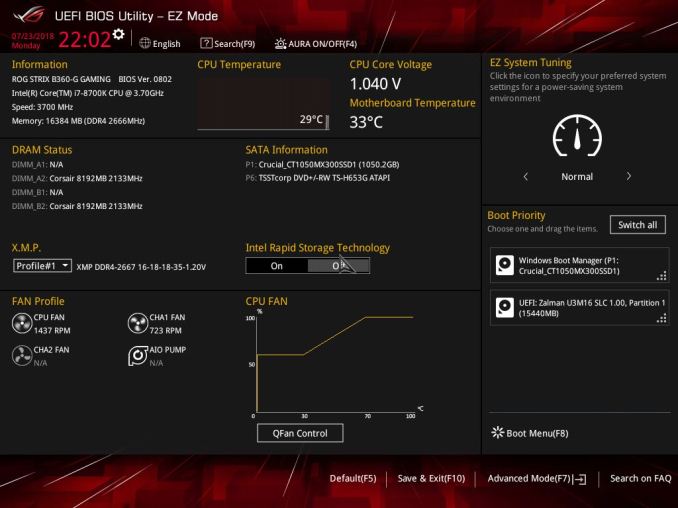
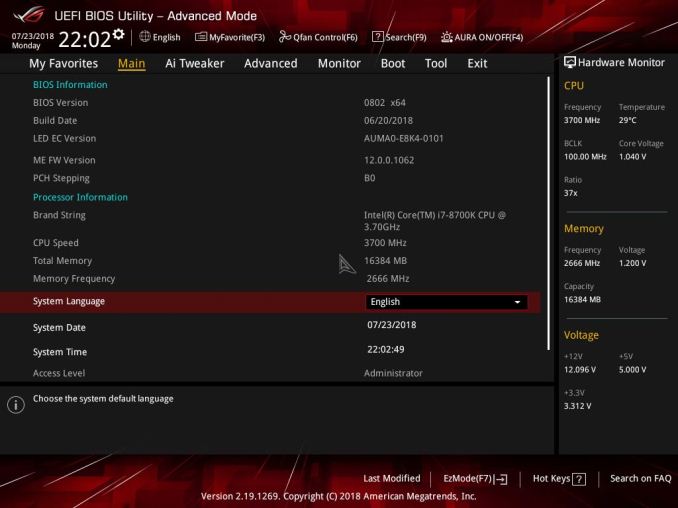
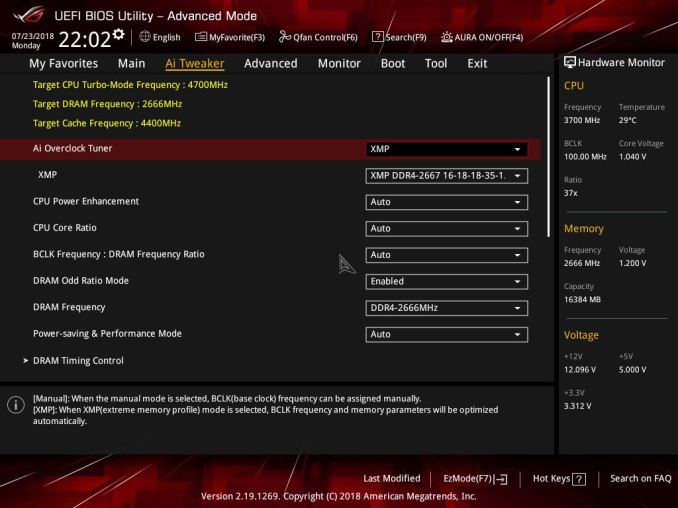
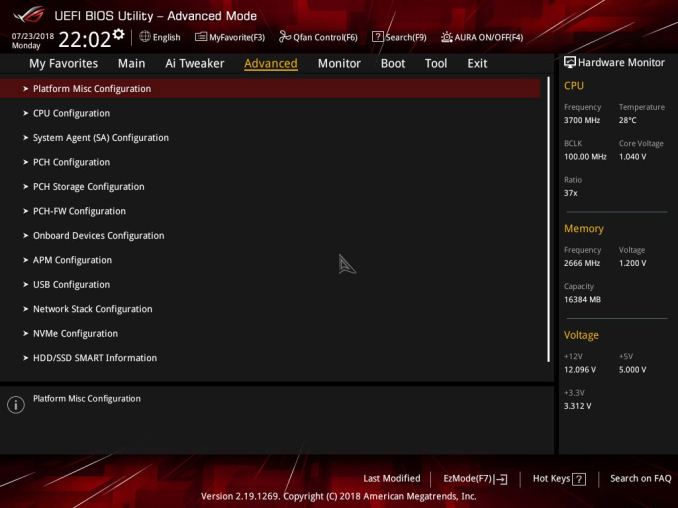
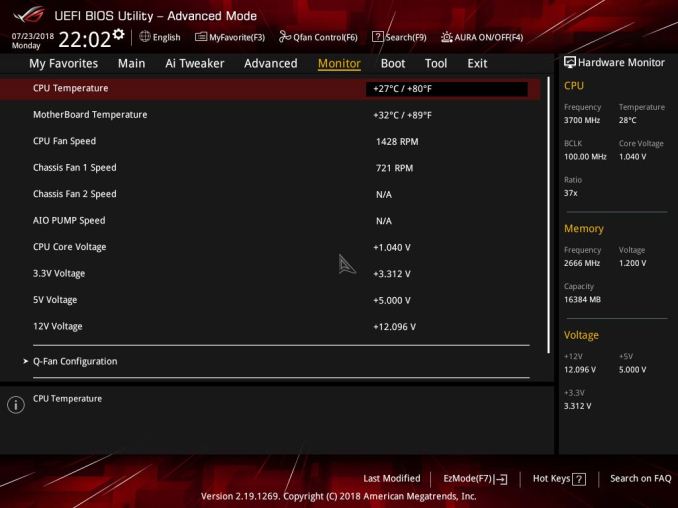
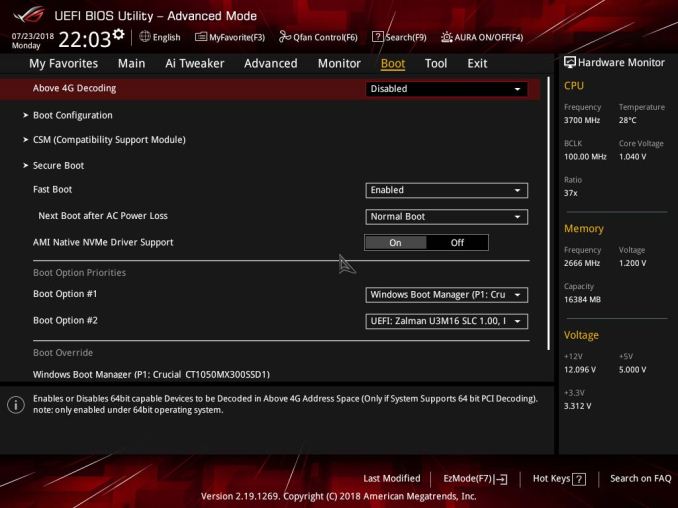







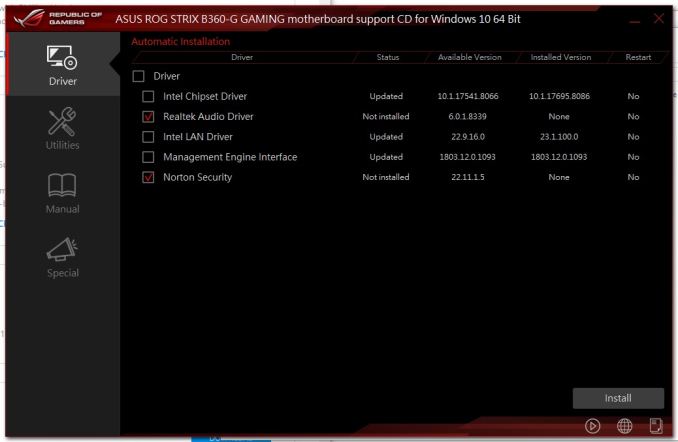
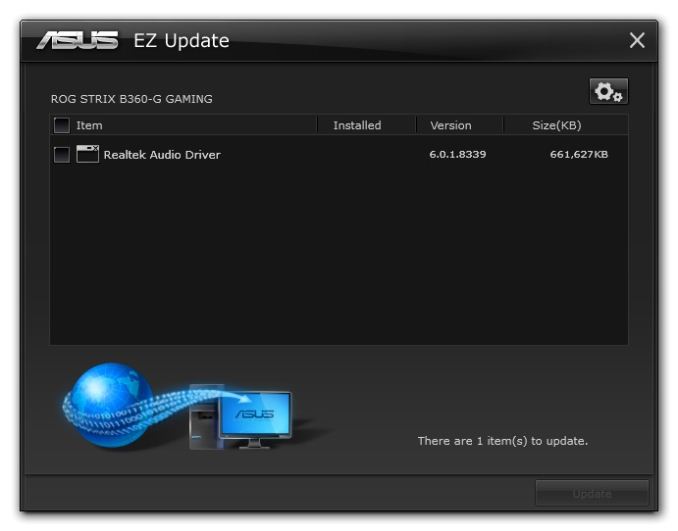
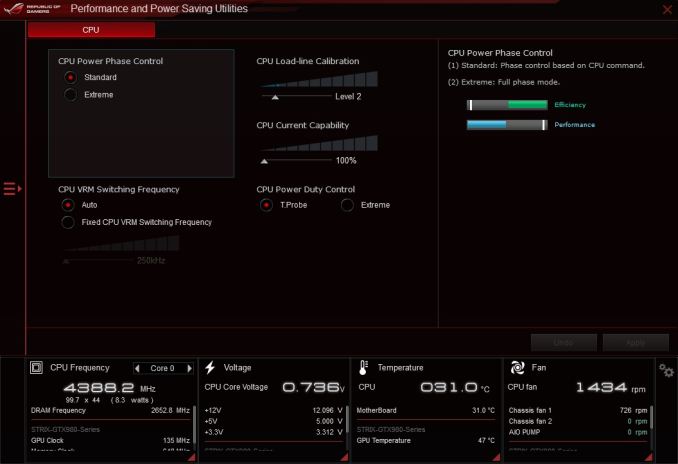
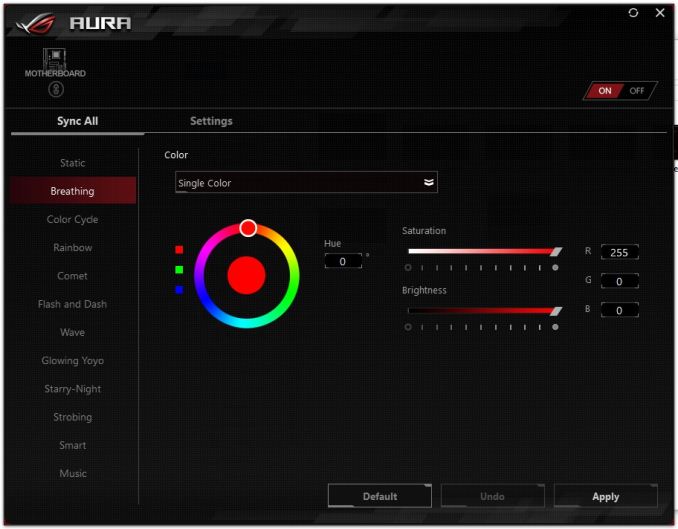
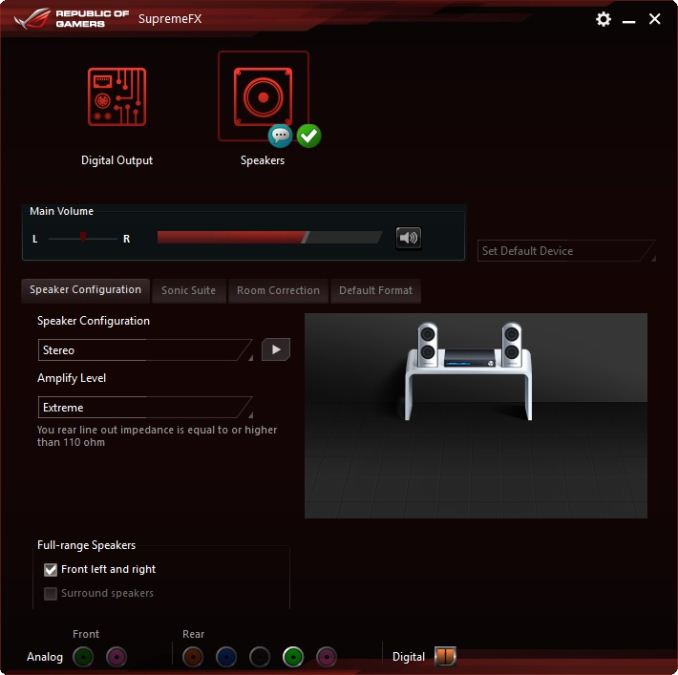
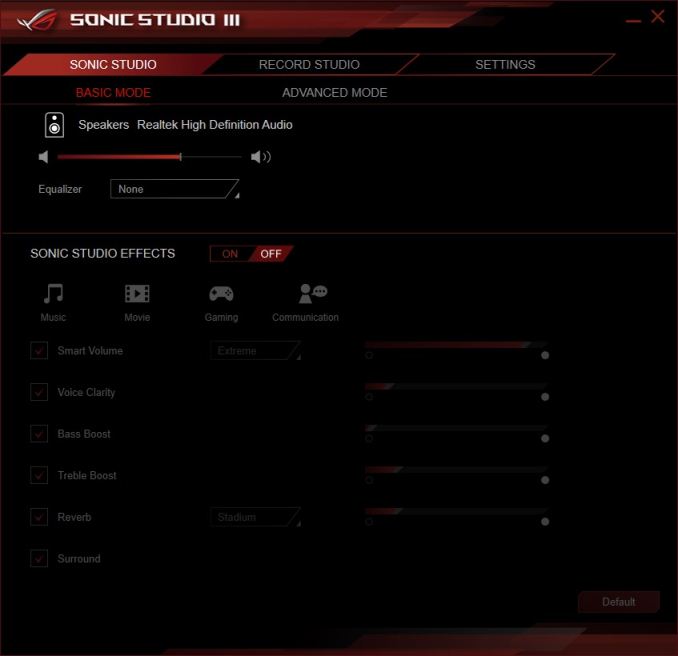














26 Comments
View All Comments
Inteli - Tuesday, September 25, 2018 - link
And I thought the B450-F was a bit gaudy...at least the stenciling wasn't red and white.Besides that, I like seeing feature-rich boards at this price point. High-end Z370/X470 boards are overkill for a lot of builders who aren't going to do much (if any) overclocking, and low-end Z370/X470 boards tend to be fairly barebones. These upscale B360/B450 boards are great since you get quite a few features without having to pay for the overkill power delivery and SLI support you'll never use. AMD does it better IMO because B450 supports overclocking, so even without the best power delivery you couod still get a couple hundred megahertz overclock.
PeachNCream - Tuesday, September 25, 2018 - link
That is an obnoxious looking motherboard!vgray35@hotmail.com - Tuesday, September 25, 2018 - link
Inside a case, nobody sees it not even you, so really, who cares what it looks like. Performance and quality matter in my opinion, and gaudy stuff and lights only increases cost for zero gain.Inteli - Tuesday, September 25, 2018 - link
If the latest case trend weren't "Tempered Glass Everywhere", I might agree with you. However, these days seeing your motherboard inside your case is pretty common with custom PCs. Aesthetics have become an important part of PC building for some.PeachNCream - Tuesday, September 25, 2018 - link
I wouldn't bother with a case that has any sort of window. My preferred desktop would sit inside a ~$30, bargain bin Rosewill mATX tower so I'd never see it as vgray implies. Despite that, I saw the stupid text on the motherboard on the first page and I didn't even bother to care about how it stacked up on subsequent benchmarks. There are lots of functional alternatives that don't look as stupid so while performance matters, I can just buy something that doesn't look like a teenage boy's skateboard.Samus - Tuesday, September 25, 2018 - link
I'd never buy a case with a window. FCC regulatory failure aside, there will inevitably be EMI and\or RFI interference due to lack of shielding near the surface components (particularely videocards) that could result in anything from coil whine and output distortion to general stability issues.Ever notice every top PC OEM throughout history has never issued a mainstream model with a window? There is a good reason for that.
Inteli - Tuesday, September 25, 2018 - link
I get your point, but anecdotally I've personally never experience any instability because of a case window, and I can't recall anybody who has.I also don't know what you define as "mainstream", but both HP and Lenovo sell PCs with side windows. If by "mainstream" you mean "not gaming-branded", I can think of a number of good reasons why they wouldn't have windows, none of which have anything to do with EM or RF interference, or FCC compliance:
* Joe Schmoe doesn't care about what the inside of his computer looks like
* Increased manufacture cost, since the side panel requires more than "bend sheet metal"
* Mainstream computers aren't built to look good inside. All you'd really see would be air ducting.
erotomania - Wednesday, September 26, 2018 - link
dumbass...glass blocks EMI better...Bonge - Thursday, September 27, 2018 - link
No only if its Lead glass and shielding effiecincy will decrease with decreasing frequency,If you buy Lead glass expect a visit from government institutions like Homeland security FBI, etc. who would inquire as to what the freak you are using that for :))
speculatrix - Saturday, November 3, 2018 - link
Well done, @Bonge, for a measured response to @erotomania's rude ignorant/wrong comment.